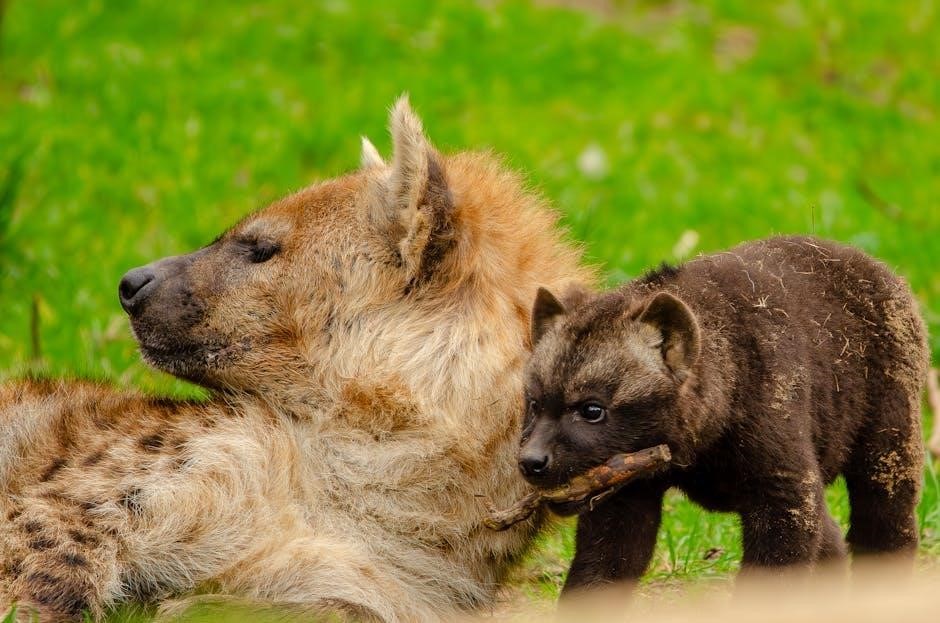Charlie’s “Workplace Survival Manual for Social Animals” highlights how understanding social dynamics and workplace challenges helps navigate professional environments effectively, fostering collaboration and personal growth.
Understanding the Importance of Social Dynamics in the Workplace
Social dynamics play a crucial role in workplace survival, as humans are inherently social animals. The ability to navigate these dynamics effectively ensures collaboration, trust, and productivity. Recognizing the strengths and weaknesses of colleagues, much like understanding the behaviors of different animal species, helps create a harmonious work environment. By fostering constructive conversations about diversity and social interactions, employees can build stronger relationships and address potential conflicts before they escalate. A well-understood social dynamic promotes inclusivity, mutual respect, and shared goals, ultimately contributing to both personal and organizational success. This foundation is essential for thriving in any professional setting.
Overview of Key Challenges Faced by Social Animals at Work
Social animals in the workplace often encounter unique challenges, despite their natural inclination toward collaboration. Navigating complex social hierarchies, managing conflicts, and balancing individual goals with team objectives are common obstacles. Recognizing the “animal nature” of colleagues, as suggested in survival manuals, can help identify strengths and weaknesses, aiding in conflict resolution. Additionally, the pressure to maintain a professional image while dealing with personal stress can lead to burnout. Understanding these challenges is crucial for developing strategies to thrive in dynamic work environments. By addressing these issues proactively, social animals can foster a more inclusive and productive workplace culture, ensuring both personal and organizational success. Effective communication and emotional intelligence are key tools in overcoming these challenges.

Mastering Workplace Communication
Effective communication is vital for social animals, requiring clarity, empathy, and adaptability to navigate diverse personalities and maintain harmony in the workplace environment successfully.
Verbal and Non-Verbal Communication Strategies
Mastering both verbal and non-verbal cues is essential for social animals in the workplace. Verbal communication involves clear, concise, and respectful dialogue, ensuring messages are conveyed effectively. Non-verbal signals, such as body language, facial expressions, and eye contact, convey emotions and intentions, often influencing perceptions more than words. Recognizing these cues helps in aligning communication strategies with colleagues’ needs. For instance, maintaining open posture can signal approachability, while active listening reinforces trust. Balancing both forms of communication fosters a harmonious and productive work environment, allowing social animals to thrive by understanding and adapting to the unspoken rules of workplace interactions. This duality ensures seamless collaboration and minimizes misunderstandings.
The Role of Active Listening in Building Workplace Relationships
Active listening is a cornerstone of workplace relationships, enabling social animals to foster trust and understanding. By fully engaging with others, employees can decode both spoken and unspoken messages, ensuring clarity and alignment. This skill helps in conflicts by allowing individuals to acknowledge perspectives, reducing misunderstandings. Techniques like maintaining eye contact, nodding, and asking clarifying questions demonstrate genuine interest. Active listening also enhances collaboration, as it encourages open dialogue and empathy. In a socially dynamic workplace, this practice strengthens bonds, making it easier to navigate challenges. By prioritizing listening, social animals can build stronger, more resilient relationships, creating a supportive and productive environment. This approach is vital for thriving in any professional setting.
Emotional Intelligence: A Cornerstone of Social Success
Emotional intelligence (EI) is a critical skill for social animals in the workplace, enabling them to navigate complex social dynamics effectively. It involves self-awareness, empathy, and the ability to manage one’s emotions while understanding others. High EI fosters stronger relationships, enhances communication, and reduces conflicts. By recognizing emotional cues, individuals can adapt their behavior to suit different situations, building trust and cooperation. In a professional setting, EI helps social animals lead, collaborate, and resolve disputes more efficiently. It also promotes a positive work environment, encouraging empathy and mutual respect. Cultivating emotional intelligence is essential for thriving in socially driven workplaces and achieving long-term career success. It empowers individuals to connect deeply, making them invaluable team members.

Navigating Office Politics
Recognizing colleagues’ strengths and weaknesses helps social animals navigate office dynamics effectively, fostering collaboration and minimizing conflicts in the workplace environment.
Identifying Key Players and Influencers in the Workplace
In the workplace, social animals must recognize the strengths and weaknesses of colleagues, much like understanding animal behaviors. Observing interactions and hierarchies helps identify key players who shape office dynamics. These individuals often hold influence over decisions and morale, making them crucial for collaboration. By understanding their roles, social animals can navigate office politics more effectively, minimizing conflicts and fostering alliances. Recognizing these dynamics, as suggested in survival manuals, allows individuals to adapt and thrive in professional environments, ensuring their voices are heard and their contributions valued. This awareness is essential for building strategic relationships and maintaining harmony in the workplace ecosystem.
Building Strategic Relationships with Colleagues
Building strategic relationships with colleagues is crucial for social animals in the workplace. By fostering trust and collaboration, these relationships create a supportive environment that enhances productivity and job satisfaction. Recognizing the strengths and weaknesses of colleagues, as highlighted in survival manuals, allows individuals to align their goals and work styles effectively. Constructive conversations and mutual respect are key to these alliances, ensuring that diversity is valued and utilized. Strong relationships also provide a network of support, helping to navigate office politics and challenges. This strategic approach not only benefits individual growth but also strengthens the overall team dynamics, creating a harmonious and efficient workplace. By investing time in these connections, social animals can thrive professionally while maintaining a positive work environment.
Understanding and Navigating Workplace Hierarchies
Understanding workplace hierarchies is essential for social animals to thrive in professional environments. Recognizing the strengths and weaknesses of colleagues, as well as their roles within the structure, helps navigate power dynamics effectively. By aligning actions with organizational goals and respecting chain of command, individuals can maintain harmony and avoid conflicts. Constructive conversations about social interactions and diversity, as facilitated by workplace survival manuals, foster an inclusive environment. This understanding enables social animals to build alliances, communicate effectively, and leverage their positions to achieve both personal and team success. Navigating hierarchies strategically ensures that social animals can adapt and grow within the workplace, contributing to a collaborative and efficient ecosystem.

Conflict Resolution and Negotiation

Recognizing animal-like behaviors in colleagues helps address conflicts through constructive conversations about social interactions and diversity. Aligning actions with organizational goals maintains harmony and effectiveness in the workplace.
Effective Techniques for Resolving Workplace Conflicts
Recognizing animal-like behaviors in colleagues, such as competitiveness or territoriality, allows for tailored conflict resolution. Active listening and staying calm are key strategies to de-escalate tensions. Encouraging open dialogue and focusing on shared goals helps align individual interests with organizational objectives. Constructive conversations about social interactions and diversity, as highlighted in the manual, foster mutual understanding. Practical strategies include seeking common ground, using non-verbal cues to diffuse stress, and leveraging emotional intelligence to navigate complex situations. By addressing conflicts proactively and maintaining a collaborative mindset, social animals can turn workplace challenges into opportunities for growth and strengthened relationships. This approach ensures harmony and productivity in dynamic work environments.
Negotiation Strategies to Maintain Harmony
Negotiation is a cornerstone of harmony in the workplace, especially for social animals. Recognizing the unique behaviors and strengths of colleagues, as outlined in the manual, allows for tailored approaches. Active listening and emotional intelligence are essential tools for understanding perspectives and finding common ground. By focusing on shared goals and fostering collaboration, individuals can navigate disagreements constructively. Practical strategies include compromising, seeking mutually beneficial solutions, and maintaining respect. Leveraging the animal-like traits of colleagues, such as adaptability and teamwork, can turn negotiations into opportunities for growth. These techniques ensure that social dynamics are harnessed to create a balanced and productive work environment, where harmony and progress coexist seamlessly. This approach is vital for thriving in today’s complex workplaces.
Maintaining Work-Life Balance
Setting clear boundaries and managing time effectively are crucial for protecting personal energy and preventing burnout, ensuring a healthy balance between professional and personal life.
Setting Boundaries to Protect Personal Time and Energy
Setting clear boundaries is essential to safeguard personal time and energy, ensuring a sustainable work-life balance. Establishing specific work hours and minimizing overtime helps prevent burnout. Prioritizing tasks and delegating when possible reduces workload. Learning to say “no” to non-essential commitments protects personal space. Creating a routine that includes downtime and self-care activities replenishes energy. Communicating boundaries assertively yet respectfully to colleagues and managers maintains professionalism while preserving personal well-being. Regularly reviewing and adjusting these boundaries ensures they remain effective in evolving work environments. By prioritizing personal time, individuals can maintain productivity and mental health, fostering long-term success and satisfaction in both personal and professional realms.
Managing Stress and Burnout in a Social Work Environment
Managing stress and burnout in a social work environment requires proactive strategies to maintain mental and emotional well-being. Recognizing early signs of burnout, such as fatigue or decreased motivation, is crucial. Techniques like deep breathing, meditation, or short breaks can help reduce stress. Prioritizing tasks and setting realistic goals prevents overwhelm. Encouraging open conversations with colleagues or supervisors fosters a supportive environment. Engaging in hobbies or activities outside of work replenishes energy and perspective. Building a strong support network, both within and outside the workplace, provides a safety net during challenging times. Regular self-care routines, such as exercise or mindfulness practices, are essential for long-term resilience. By addressing stress early, professionals can maintain their passion and effectiveness in their roles.

Building a Strong Professional Network
A robust professional network enhances career growth and workplace survival, providing support and opportunities through meaningful connections with mentors, peers, and industry leaders.

The Importance of Mentorship in Career Growth

Mentorship is a cornerstone of career growth, offering guidance, support, and valuable insights from experienced professionals. It helps social animals navigate workplace dynamics, build confidence, and make informed decisions. A mentor can provide tailored advice, share industry knowledge, and help individuals avoid common pitfalls. Finding the right mentor fosters resilience and adaptability, essential traits for thriving in competitive environments. Mentorship programs or informal relationships can equally empower individuals to align their goals with organizational expectations. By leveraging mentorship, social animals can enhance their professional skills, strengthen their network, and achieve long-term success in their careers.
Networking Strategies for Social Animals
Networking is a vital skill for social animals, allowing them to build connections and opportunities. Attending industry events, joining professional groups, and engaging in conversations can expand their network. Active listening and showing genuine interest in others foster deeper relationships. Social animals should focus on providing value, whether through sharing knowledge or offering support, to create mutually beneficial connections. Regular follow-ups and maintaining visibility ensure relationships stay strong. Leveraging both online platforms and in-person interactions diversifies networking efforts. By being approachable, authentic, and proactive, social animals can cultivate a robust professional network that supports their career growth and workplace success.

Mastering workplace survival as a social animal involves understanding dynamics, building relationships, and adapting strategies to thrive, ensuring personal and professional growth in any environment.

